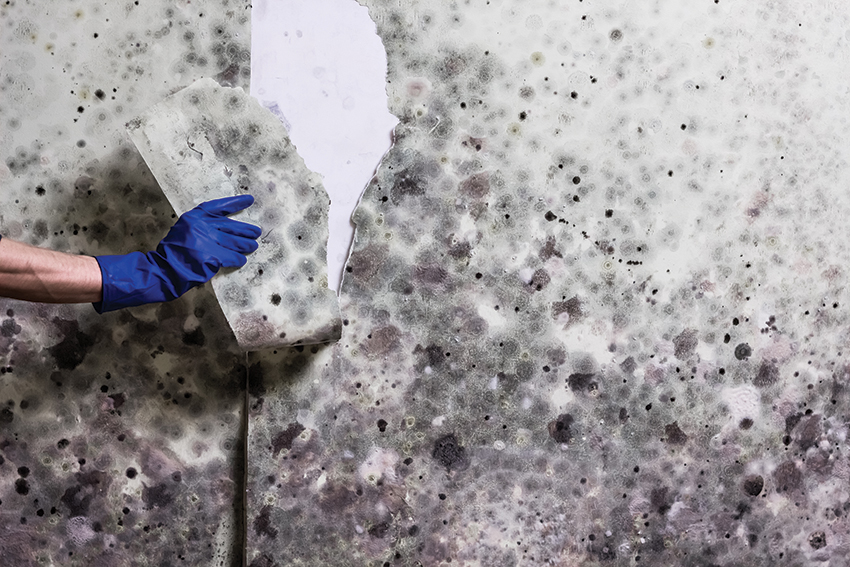
Following a record-breaking wet start to 2022, addressing mould elimination and prevention is high on the to-do list.
While it may be unnerving to see dark spots develop and then spread across the ceiling, walls, furniture or surfaces, or notice the intensification of an earthy smell over time, the good news is that all mould can be treated.
There are products on the market that help with mould elimination on hard and soft surfaces – many that have been developed in Australia, and have proven to kill mould, remove signs of dead mould and prevent future colonisation.
What causes mould to grow?
High moisture and humidity play key roles in facilitating mould growth. Under the right conditions, mould can develop within 24 hours and then continue to grow and spread for weeks and months.
Northern parts of Australia which experience long periods of high humidity and regions impacted by recent flooding and heavy rainfall are more likely to experience visible mould growth.
What are the health implications of mould?
The presence of mould should never be ignored. If left untreated, mould will release spores to continue growth.
Spores can travel through the air, potentially causing health issues when inhaled – particularly for people who have asthma or are allergic to mould.
Dead mould breaks down to mycotoxins which depress the immune system, potentially causing headaches, sore eyes and running noses.
Where can mould be found?
Furnishings and clothing – Shoes, bags, cushions, lounge chairs, and other soft furnishings can develop visible mould after becoming damp, wet or in environments of high humidity. Spots of varying colours or a strong musty smell are sure signs of mould. Mould can be cleaned from most surfaces and furnishings, and ongoing treatment can prevent further mould growth however, some items may be unsalvageable, particularly when flooding or excess water damage has occurred.
Carpets – Water damaged carpet is likely to develop mould in 24 to 48 hours. While mould is easily visible on surfaces such as walls and ceilings, mould can go unnoticed under carpets. A musty odour increased allergic reactions, or black, green or white spots indicate that the carpet is growing mould. Lifting a corner of the carpet will confirm if mould is present and the extent of the growth.
Wood and building materials – Most fungi can start growing on surfaces with wood moisture content of 16 per cent and above. Often, dry, tolerant moulds are the first to grow in the early stages of water damage. While visible mould is easily recognisable, it is when mould is hidden that it has the opportunity to thrive and can present significant risks to the health of occupants. Microbial air samples and/or surface samples can be used to measure indoor environmental conditions and detect the presence of mould and bacteria hidden within wall and ceiling cavities. Once detected, mould concentrations should be effectively reduced using professional remediation techniques.
Air conditioning and heating systems – There’s nothing more concerning than the thought of breathing in contaminated air. Air conditioning systems often harbour mould and mildew and spread airborne spores for more colonies to form. This may pose significant health risks. Outside air is drawn into the air conditioning system and cooled, and over time, particles and unwanted contaminants accumulate in the system. Tell-tale signs that mould may be present in an air conditioning system are a musty, earthy smell or visible mouldy spots around air vents. Once detected, a mould remediation specialist can provide solutions to kill and prevent future mould growth.
How to remove mould
With any mould remediation activity, protective clothing should be worn including rubber gloves, eye protection, suitable footwear, overalls, and a face mask.
Good ventilation is also essential. In situations of flooding or excess water damage, a mould remediation specialist should be called on for expert advice and services.
Mould remediation products that incorporate hydrogen peroxide as a bacterial killing agent will provide a high-speed kill of existing mould.
Tips for eliminating and preventing mould after water damage:
- Remove unsalvageable mould or water-affected contents immediately from the indoor space.
- Increase air ventilation and dehumidification to dry out indoor spaces.
- Identify where mould may be present, including ceiling cavities and walls – visible signs on surfaces or the presence of a musty or earthy smell.
- Clean mould and water-damaged areas and furnishings with proven solutions that kill mould and bacteria on contact and provide lasting protection.
- Wearing protection clothing, apply products specially formulated to kill and prevent the regrowth of mould.
- Leave mould fighting solutions wet on the surface for up to 15 minutes or longer. Check the product packaging or the Instructions for Use (IFU) for the time required for the effectiveness of individual products.
- Include mould remediation as part of ongoing cleaning and disinfection practices after heavy rain. Even after successful water damage restoration/remediation jobs, it is pertinent to keep indoor surfaces clean and air temperatures/relative humidity within standards.
- Continue to control indoor humidity using a dehumidifier or air conditioning unit. Ideally, indoor humidity levels should be around 30-65 per cent to inhibit mould growth.
Shani Troubady is an air quality and applied scientist at Aeris Environmental. Troubady specialises in mould and heating, ventilation and air conditioning (HVAC) remediation projects for commercial and residential properties, medical facilities and construction sites across Australia.
This article first appeared in INCLEAN NZ magazine. Read the original article here.